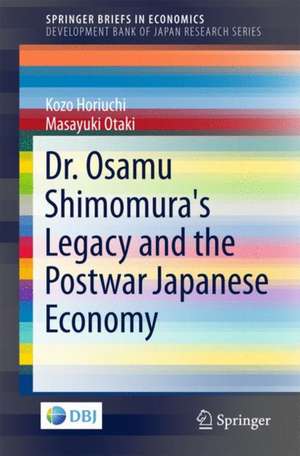Dr. Osamu Shimomura's Legacy and the Postwar Japanese Economy: SpringerBriefs in Economics
Autor Kozo Horiuchi, Masayuki Otakien Limba Engleză Paperback – 30 aug 2017
Succinctly, Shimomura is a Keynesian who believes the vigor in its private sector but recognizes that Japanese economy urgently needs the government’s auxiliary macroeconomic policies. This book emphasizes that the rapid Japanese growth owes mainly to affluent entrepreneurship filled in the economy not to the sheer government’s planning. Dr. Shimomura’s theory endorses our assertion.
Din seria SpringerBriefs in Economics
-
 Preț: 444.35 lei
Preț: 444.35 lei -
 Preț: 264.79 lei
Preț: 264.79 lei - 15%
 Preț: 462.51 lei
Preț: 462.51 lei -
 Preț: 47.33 lei
Preț: 47.33 lei -
 Preț: 353.14 lei
Preț: 353.14 lei -
 Preț: 273.32 lei
Preț: 273.32 lei -
 Preț: 376.04 lei
Preț: 376.04 lei -
 Preț: 379.09 lei
Preț: 379.09 lei -
 Preț: 380.07 lei
Preț: 380.07 lei -
 Preț: 377.35 lei
Preț: 377.35 lei -
 Preț: 379.09 lei
Preț: 379.09 lei -
 Preț: 376.59 lei
Preț: 376.59 lei -
 Preț: 408.27 lei
Preț: 408.27 lei -
 Preț: 379.09 lei
Preț: 379.09 lei -
 Preț: 383.27 lei
Preț: 383.27 lei -
 Preț: 378.54 lei
Preț: 378.54 lei -
 Preț: 377.95 lei
Preț: 377.95 lei -
 Preț: 340.23 lei
Preț: 340.23 lei -
 Preț: 380.25 lei
Preț: 380.25 lei -
 Preț: 378.12 lei
Preț: 378.12 lei -
 Preț: 376.04 lei
Preț: 376.04 lei -
 Preț: 376.04 lei
Preț: 376.04 lei -
 Preț: 379.68 lei
Preț: 379.68 lei -
 Preț: 381.00 lei
Preț: 381.00 lei -
 Preț: 375.23 lei
Preț: 375.23 lei -
 Preț: 376.80 lei
Preț: 376.80 lei -
 Preț: 378.54 lei
Preț: 378.54 lei -
 Preț: 377.57 lei
Preț: 377.57 lei -
 Preț: 376.04 lei
Preț: 376.04 lei -
 Preț: 378.92 lei
Preț: 378.92 lei -
 Preț: 375.62 lei
Preț: 375.62 lei -
 Preț: 379.09 lei
Preț: 379.09 lei -
 Preț: 353.67 lei
Preț: 353.67 lei -
 Preț: 342.14 lei
Preț: 342.14 lei -
 Preț: 375.45 lei
Preț: 375.45 lei -
 Preț: 379.09 lei
Preț: 379.09 lei -
 Preț: 377.35 lei
Preț: 377.35 lei -
 Preț: 344.86 lei
Preț: 344.86 lei -
 Preț: 377.35 lei
Preț: 377.35 lei -
 Preț: 345.89 lei
Preț: 345.89 lei -
 Preț: 377.57 lei
Preț: 377.57 lei -
 Preț: 343.83 lei
Preț: 343.83 lei -
 Preț: 378.12 lei
Preț: 378.12 lei -
 Preț: 345.06 lei
Preț: 345.06 lei -
 Preț: 379.48 lei
Preț: 379.48 lei -
 Preț: 379.48 lei
Preț: 379.48 lei -
 Preț: 380.07 lei
Preț: 380.07 lei -
 Preț: 375.45 lei
Preț: 375.45 lei -
 Preț: 445.33 lei
Preț: 445.33 lei -
 Preț: 378.54 lei
Preț: 378.54 lei
Preț: 411.75 lei
Nou
Puncte Express: 618
Preț estimativ în valută:
78.80€ • 82.16$ • 65.49£
78.80€ • 82.16$ • 65.49£
Carte tipărită la comandă
Livrare economică 21 martie-04 aprilie
Preluare comenzi: 021 569.72.76
Specificații
ISBN-13: 9789811057618
ISBN-10: 9811057613
Pagini: 90
Ilustrații: XI, 113 p. 15 illus., 5 illus. in color.
Dimensiuni: 155 x 235 mm
Greutate: 0.19 kg
Ediția:1st ed. 2017
Editura: Springer Nature Singapore
Colecția Springer
Seriile SpringerBriefs in Economics, Development Bank of Japan Research Series
Locul publicării:Singapore, Singapore
ISBN-10: 9811057613
Pagini: 90
Ilustrații: XI, 113 p. 15 illus., 5 illus. in color.
Dimensiuni: 155 x 235 mm
Greutate: 0.19 kg
Ediția:1st ed. 2017
Editura: Springer Nature Singapore
Colecția Springer
Seriile SpringerBriefs in Economics, Development Bank of Japan Research Series
Locul publicării:Singapore, Singapore
Cuprins
1 Introduction.- Part I Vision, Theory, and Policy: High Growth and Zero Growth.- 2 Postwar Reconstruction.- 3 Vision of High Growth and Performance in 1960s.- 4 Vision of Zero Growth and Performance After the Oil Crisis.- PART II Implications of Zero Growth Vision:Lost Decades, Sustainability, and Corporate Management.- 5 Current Era of Zero Growth.- 6 Sustainability and Corporate Management.- 7 Conclusion.- Index.
Notă biografică
Kozo Horiuchi is a professor emeritus, Hosei University, Tokyo, Japan. He received his BA from the Department of Commerce, Hitotsubashi University in 1968. He then joined the Development Bank of Japan and received his MA from the Graduate School of Johns Hopkins University in 1973. Returning from the US, he served as a research officer before becoming Chief Economist at the Research Institute of Capital Formation, DBJ. He received his Doctor of Business Administration from Hosei in 2008. While teaching at Hosei, he also studied at the Beijer Institute, the Royal Swedish Academy of Sciences.Masayuki Otaki is a professor of economics at the University of Tokyo Institute of Social Science, and academic advisor at the Research Institute of Capital Formation, Development Bank of Japan. His main areas of research are macroeconomic theory, environmental economics, educational economics, and economic thought. Born in 1957, Prof. Otaki received a Bachelor’s degree in economics from the University of Tokyo in 1981 and a Ph.D. in economics from the University of Tokyo in 1990. He was appointed professor of economics at the University of Tokyo Institute of Social Science in 2001.
Caracteristici
Analyzes the role of the market and government during the High-Growth era of Japan prudently Portrays the life of an influential and liberal policy maker of "Income Doubling Plan’’, Dr. Shimomura, with a concise post War Japanese economic history Provides vision and theory for sustaining Japanese already matured Japanese society referring to experiences of the High-Growth era Includes supplementary material: sn.pub/extras
